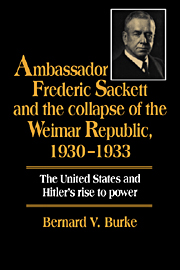Book contents
- Frontmatter
- Contents
- Acknowledgments
- Abbreviations used in the notes
- Introduction
- 1 A time of opportunity
- 2 American diplomacy, official and unofficial
- 3 The landslide election
- 4 Sackett takes the initiative
- 5 Sackett and the financial crisis
- 6 Perceptions of Nazism and communism, with an afterthought on fascism
- 7 One end, two paths: Brüning and Hitler in conflict
- 8 Efforts to sustain representative government in Germany
- 9 Sackett loses heart with Brüning's fall
- 10 The decline of Hitler and the Nazis
- 11 Through a glass darkly
- Conclusion
- Bibliography
- Index
2 - American diplomacy, official and unofficial
Published online by Cambridge University Press: 30 September 2009
- Frontmatter
- Contents
- Acknowledgments
- Abbreviations used in the notes
- Introduction
- 1 A time of opportunity
- 2 American diplomacy, official and unofficial
- 3 The landslide election
- 4 Sackett takes the initiative
- 5 Sackett and the financial crisis
- 6 Perceptions of Nazism and communism, with an afterthought on fascism
- 7 One end, two paths: Brüning and Hitler in conflict
- 8 Efforts to sustain representative government in Germany
- 9 Sackett loses heart with Brüning's fall
- 10 The decline of Hitler and the Nazis
- 11 Through a glass darkly
- Conclusion
- Bibliography
- Index
Summary
When Ambassador Sackett assumed his post in Berlin, in February 1930, the last majority cabinet in the history of the Weimar Republic was about to fall. What appeared to be the imminent collapse of the republic was fostered and welcomed on the political Right and Left. Observers at the time were uncertain about the direction Germany would take. Many feared that the Communist party was most likely to benefit from the turmoil. Sackett must therefore be credited with singling out Hitler and the Nazis as the major threat to the Weimar Republic soon after his arrival in Berlin. It is ironic that Sackett, appointed because of his qualifications in business and finance, would distinguish himself in political analysis. He had more time for that activity because he was kept out of the loop of decisions concerning the major American influence on the Weimar Republic – financial support. The ambassador was deliberately excluded from wielding this primary tool of foreign policy because American economic diplomacy left financial relations to the private sector.
Sackett, as a newcomer, was expected to learn the duties of a diplomat from his experienced staff of foreign service officers. He was fortunate to have John Cooper Wiley at his side while he acquainted himself with his day-to-day responsibilities, with the routine of the embassy chancery, with representing American interests to the Germans, and with the intricacies of reporting to the State Department. Sackett was a good student and an excellent administrator. He took to his tasks with aplomb and was quickly running the embassy and turning out impressive financial and political reports.
- Type
- Chapter
- Information
- Publisher: Cambridge University PressPrint publication year: 1995



